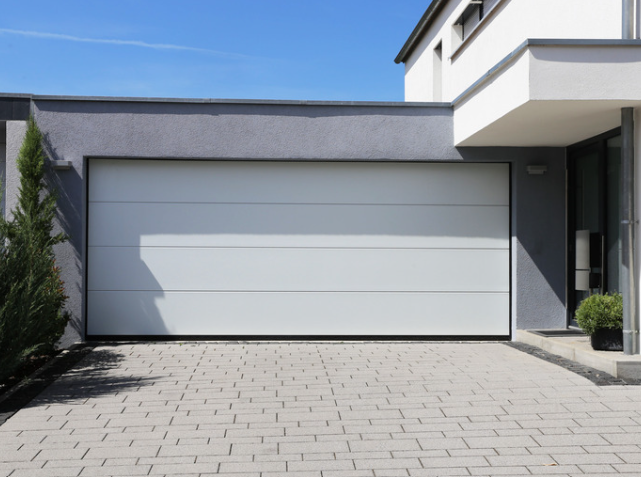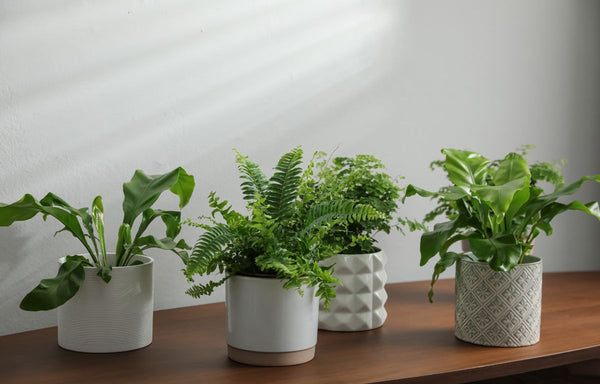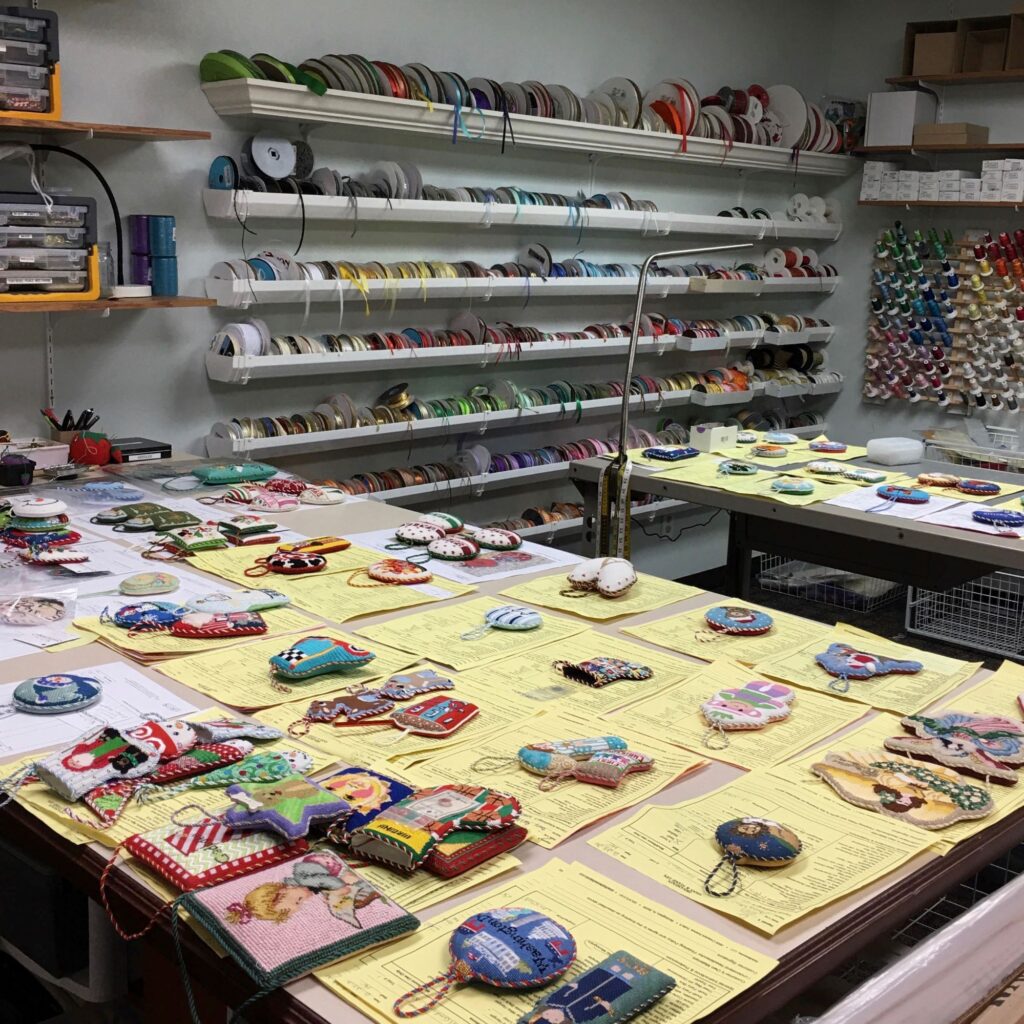Discover common houseplant problems and their solutions, from black spots and crispy leaf edges to slow growth and wilting. Get tips on maintaining your indoor plants' health and addressing issues like yellowing leaves, fungal growth, and insect infestations.More
Houseplants are a wonderful addition to any home, bringing life and beauty to your living space. However, even the most well-intentioned plant parents can encounter common problems when caring for their leafy friends. Don't worry, though, with a little knowledge and some TLC, you can not only overcome these problems but learn and implement the solutions into your regular plant care and maintenance routine.

Black Spots:
Problem: Black spots on houseplant leaves and stems are often caused by fungal or bacterial diseases, such as leaf spots or black mould. These pathogens thrive in humid or moist conditions and can damage plant tissues, reducing photosynthesis and weakening the plant.
Solution: Remove and destroy affected plant parts to treat black spots on houseplant leaves and stems caused by fungal or bacterial diseases. Improve air circulation, maintain proper spacing, and avoid overhead watering. Use fungicides as recommended for severe cases and isolate the plant to avoid contaminating healthy ones.
Brown or Crispy Leaf Edges:
Problem: Houseplant leaves develop crispy and brown edges due to insufficient humidity or inconsistent watering. Dry air and underwatering causes the plant to lose vital moisture in natural transpiration. For plants that are already parched, this leads to dehydration and damage to the leaf margins.
Solution: To remedy crispy and brown-edged leaves on houseplants, increase humidity by misting the plant, using a humidity tray, or placing a small humidifier nearby. Ensure consistent watering, allowing the top inch of soil to dry before watering again, and consider repotting if the roots are pot-bound and unable to absorb moisture from the soil.
Curling Leaves:
Problem: Leaves curl up in response to heat as a protective mechanism to reduce water loss through transpiration and increased exposure to intense sunlight. This curling helps the plant conserve moisture and maintain its overall health during hot conditions, ultimately aiding its survival.
Solution: To alleviate leaf curling caused by heat stress, relocate the plant to a shadier spot, boost humidity with misting or trays, ensure proper watering, enhance air circulation, and consider shade cloth. Monitor temperatures and be patient for recovery. Slowly acclimate your plant to increasing levels of sunlight to avoid overexposing it too quickly.

Discolouration, Bleached Flecks and Large Brown Patches:
Problem: This describes leaf burning, which typically occurs due to excessive direct sunlight. It initially manifests as discoloured patches on the leaves but can then evolve to entirely bleached areas or even brown patches if left exposed.
Solution: Move the plant away from direct sun or filter the light with sheer curtains. However, gradually acclimate the plant to decreased light conditions to allow it to recover and prevent further damage.
Dropping Leaves or Shedding Prematurely:
Problem: Stress is usually the reason why houseplants drop their leaves. It is a way for them to conserve energy to survive prolonged, unhealthy growing conditions.
Solution: Stress is a precursor to major, irreversible issues so you should have enough time to diagnose the problem and treat it. Other symptoms will likely foreshadow the plant’s unhappy state such as dry soil, soft or yellowing leaves, black spots, etc.
Exceedingly Slow Growth:
Problem: Insufficient Lighting is likely the cause of slow growth as the plant is not receiving enough sunlight to process photosynthesis, creating energy for stem and foliage production.
Solution: Move your plant into a brighter position. If your plant has been kept in a dimly lit area for a while, slowly acclimatise it to higher levels of sunlight to avoid heat stress. Consider using artificial grow lights for low, naturally lit areas. Wipe down the stems and leaves of your plant as dust and grime can stick to the surface, suffocating the pores and preventing light absorption.
Flowering With Little To No Foliage Growth:
Problem: Houseplants may over flower due to excessive stress, such as prolonged exposure to extreme temperatures, inadequate light, drought conditions or ineffective fertilisers. Plants will often do this in order to quickly reproduce before they die. In this instance, new stems and leaf growth will drastically slow or stop altogether as the plant is diverting its remaining energy into flower production.
Solution: Prune or deadhead excessive flowers to redirect energy toward leaf and root growth. Increase nitrogen-rich fertilisers, and ensure the plant receives appropriate sunlight, temperature levels, and adequate watering to ease stress. It is good to research your plant as flowers can be an indicator that your plant has finished growing even with treatment.
Leggy or Sparse Growth With Small Leaves:
Problem: Houseplants often produce leggy growth due to insufficient sunlight. In low-light conditions, plants stretch and elongate their stems to reach for more light, resulting in tall, weak, and spindly stems with very little leaf production.
Solution: Relocate the plant to a brighter spot with appropriate lighting conditions, such as near a window with indirect sunlight or consider using artificial grow lights to supplement the light needs of the plant. Increase the frequency of fertilisation to boost nutrients in the soil and promote larger and more abundant foliage growth.

Lopsided and Leaning Growth:
Problems: Houseplants often develop lopsided growth due to uneven light exposure. When a plant leans or grows more on one side, it attempts to reach the light source, causing an uneven appearance. However, if the whole plant is leaning to one side, it might be because the soil has become displaced and is unable to securely hold the roots inside of the pot.
Solution: To correct lopsided growth in houseplants caused by uneven light exposure, rotate the plant periodically to ensure all sides receive equal light. Pruning or pinching back leggy or overgrown branches can also help promote a more balanced and symmetrical appearance. If the entire plant is leaning to one side and feels loose in the soil, you may need to secure the main stem with a support like a stake or trellis and replace any lost soil. Lightly compress the top of the soil down to create a firmer consistency if needed but be careful not to crush the roots.
Not Flowering:
Problem: Houseplants may not flower due to various reasons, including insufficient light, inadequate fertilisation, overcrowded roots, improper pruning, or stress caused by factors like inconsistent watering or extreme temperature fluctuations. Also, some plants lose the ability to flower with age.
Solution: Ensure the plant receives the right amount of light based on their species' requirements. Fertilise with a balanced, water-soluble fertiliser during the growing season. Repot when roots become overcrowded, prune to encourage branching, and maintain consistent care with appropriate watering, temperature, and humidity levels. Try moving the plant outdoors. Natural environments can invigorate and promote stronger and more abundant growth.
Pale Green Leaves:
Problem: Leaves typically turn a pale green colour due to insufficient light exposure. When a plant doesn't receive enough light, it reduces chlorophyll production, leading to a loss of green pigment and resulting in leaves that are less vibrant.
Solution: Relocate the plant to a position with brighter, indirect sunlight. Ensure it receives the appropriate light intensity and duration according to its specific species requirements to promote healthy green foliage. Depending upon the seasons, the most popular varieties of houseplants typically require bright, indirect sunlight for at least five hours per day.

Powdery Texture Mostly on the Leaves:
Problem: There are two common causes for the presence of a powdery substance on your plant, particularly the leaves. The first could simply be mineral buildup from misting the plant with regular tap water or even just settled dust. Although these can block the plant's pores neither should pose a significant immediate risk. The more serious issue is powdery mildew. This is caused by high humidity combined with poor air circulation resulting in a fungal disease. Powdery mildew can readily spread, inhibiting photosynthesis and weakening the plant.
Solution: Gently wipe the leaves and stem with a warm, soft cloth. Mineral build-up should come away very easily with little to no harm to the plant. If the powder is waxy in texture or leaves a residue when wiped, it is likely fungal. To combat powdery mildew on houseplants, increase air circulation by using a fan and reduce humidity levels. Remove affected leaves and consider applying a fungicidal spray specifically designed for powdery mildew. Isolate the infected plant to prevent the spread to other plants.
Protruding Roots:
Problem: Roots will usually protrude above the soil due to overcrowding or if the depth of the plant is too shallow. As the plant outgrows its pot, the roots will seek space and oxygen, pushing themselves upwards and becoming visible.
Solution: Repot your plant into a larger container that has suitable space to allow for future downward growth and expansion. Generally speaking, most pots should be at least 7cm wider and deeper than the plant’s current root system. The frequency of repotting your plant will depend on how well the plant is growing in its environment.

Soft and Limp Foliage:
Problem: Soft foliage in houseplants is typically caused by overwatering. When the plant's roots are saturated, the leaves become waterlogged, resulting in a soft, limp texture. Correcting the watering schedule is essential to restore healthy foliage.
Solution: If the potting soil is very wet, check the roots for rot. Cut away any infected ones and repot the plant with new potting soil. Ensure proper drainage in the pot and wait for the soil to dry out between waterings. Trim any severely affected leaves and monitor your watering habits to avoid underwatering your plant.
Torn or Missing Leaves:
Problem: Torn or missing leaves on houseplants are often caused by physical damage, such as strong winds, accidental grazing or treading, pet nibbling, or rough handling. Leaves can also show signs of damage due to insect and pest activity. Thoroughly inspect the underside of the leaves and around the nodes on the stems.
Solution: Take preventive measures by placing plants out of reach of pets and children and away from areas with high foot traffic. Only handle the plant for general maintenance and care. Trim damaged leaves neatly and provide proper care conditions to encourage new, healthy growth. Treat any pests or insects with neem oil or an organic pest and insecticide if needed.
Unusually Slow Growth:
Problem: Houseplants may not grow due to various factors, including old age, insufficient light, improper watering, lack of nutrients, crowded roots, or plant stress. Identifying and addressing the specific issue is essential for promoting healthy growth.
Solution: To encourage growth in houseplants, provide the correct amount and type of light, and water consistently but avoid overwatering, fertilize with a balanced, water-soluble fertilizer, repot if roots are crowded, and ensure proper care practices to reduce stress on the plant. Once plants reach a certain age, they no longer have the capability to produce new growth. Propagation is a great way of extending the spirit life of your plant and forming new attachments from its offspring.

Wilting Despite Proper Care:
Problem: Wilting is usually a sign that the plant is not receiving sufficient growing requirements. This could be sunlight, nutrients, water, etc. However, given proper care, the likely cause for this lies underneath the soil. Although plants convert sunlight and carbon dioxide into energy to grow, the roots are where vital water, oxygen and nutrients are absorbed for sustaining life.
Solution: Check the condition of the roots to ensure they are not desiccated or rotten due to under or overwatering. If the soil is wet, either mix in dry soil to absorb some of the excess moisture or replace the entire soil with a new mix. Fully flush dry soil with fresh water and let excess moisture drain away. Repot the plant if the roots have become potbound as they have not been able to expand for nutrient, oxygen and water absorption. Cut away any roots that are damaged but if they appear to be unsalvageable, propagate healthy parts of the plant to start anew.
Yellowing Leaves:
Problem: Yellowing leaves are different from leaves that are bleaching or paling in colour. The most common reason for houseplant leaves turning yellow is overwatering. Excessive moisture in the soil can prevent roots from absorbing vital nutrients and oxygen. This yellows the leaves as the plant can't sustain its green chlorophyll production.
Solution: Allow the soil to dry out between waterings and ensure proper drainage. Trim any damaged yellow leaves, repot if necessary, and adjust your watering schedule to meet the specific needs of your plant species.
Waterlogged or Foul-Smelling Soil:
Problem: This usually occurs when the soil becomes waterlogged and develops a bad smell due to overwatering, which suffocates the plant's roots and leads to root rot. It creates a stagnant, anaerobic environment in the soil that emits an unpleasant odour caused by bacteria or fungal infections.
Solution: Allow the topsoil to dry out before watering again. However, if the soil is producing a rotten odour, you will need to immediately remove the plant from the pot. Wash the roots under running water to check if they have become infected, and thoroughly disinfect your pot. Cut away any black and mushy roots and repot your plant with entirely new soil.

White Waxy or Fuzzy Spot and Misshapen Leaves:
Problem: White, waxy or fuzzy spots on houseplant leaves and stems typically result from the presence of scale insects like Mealybugs that secrete a waxy coating. While misshapen leaves can be due to an Aphid infestation. These pests attach themselves to the plant and feed on the sap, causing to misshapen and lumpy textured leaves. They weaken the plant's immune system to other harmful diseases and infections. They appear as tiny yellow, green or black speckles underneath the leaves and around the stem's nodes.
Solution: It is vital that infested plants are isolated to stop the spread to other healthy plants. Give the entire plant a cleanse using a gentle cloth and warm water. This will physically remove pests from the plant. Prune heavily infested parts and use pest, insecticides or neem oil for more severe infestations being mindful of hard-to-reach areas like in between the nodes and around the base of the stems.
Although it seems like this is a dauntingly long list of problems, for the most part, houseplants are self-sufficient and very resilient. Give your houseplants a general wellbeing check every month or so, regardless if they are exhibiting signs of stress or disease. Catching potential problems early will ensure your plants stay happy and healthy for years to come.
Read on if you'd like to learn about African Violets.














